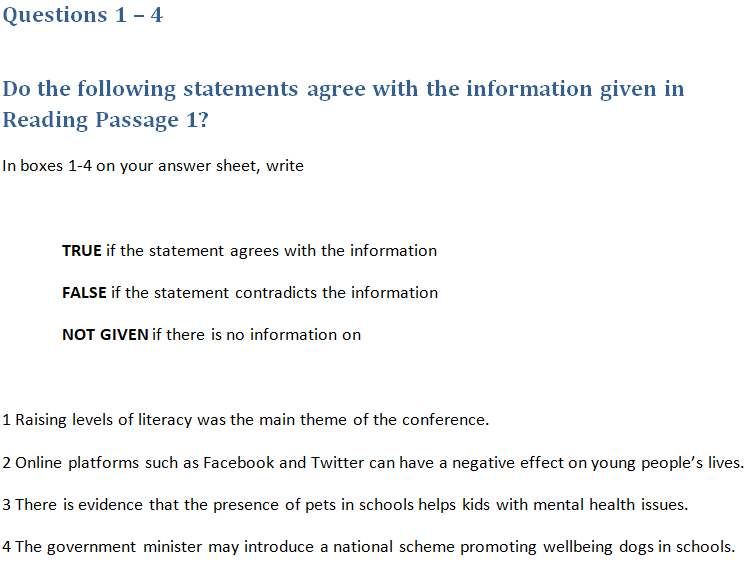Introduction
In the IELTS Reading identifying information (True/False/Not given) task, you will be given a text and a set of statements. You will need to read the text and ascertain whether each statement is true, false or not given as per the given text.
Most of us have experienced True / False questions in our academic life, but we have not had any exposure to Not-given questions. This adds a new dimension to the True / False questions we have experience with. This is why a solid strategy is needed to counter these questions successfully.
IELTS Reading Identifying information sample task

Downloadable link to the text

Downloadable link to the questions
Tips
Avoid wasting too much time on the not-given statements
One of the biggest challenges with this task is that you will need to read the text for information not given in it. This can be very expensive in terms of time as you can end up re-reading the text a few times to confirm that you have chosen the correct answer for the not-given statement.
Answers appear in the same order as the text
A saving grace about these questions is that the answers will appear in the same order as the text. This means that the information needed to answer the first question will appear first in the given text. The information for the second question will appear after the information for the first question and so on.
Identify the synonyms and paraphrases
Synonyms and paraphrases will be used throughout. Don’t expect a word-to-word match between the statements and the text.
A synonym is a similar meaning word.
A paraphrase is to say something in your own words using different words to make it easier to understand.
Avoid using your previous knowledge of a given subject
You might come across a subject on which you have previous knowledge. You must avoid using any previous knowledge in answering these questions, Stick to what you know about the subject from the given text.
IELTS Reading Identifying Information strategy
Read the question
Read the question carefully and identify whether it is a True / False / Not given or a Yes / No / Not given question.
Identifying this difference is important.
True / False / Not given – These questions deal with facts about a topic.
Yes / No / Not given – These questions deal with the point of view, opinions and beliefs of the people mentioned in the text.
Read the statements carefully
Read the statements carefully and understand their meaning. Understanding the meaning is important as exact words might not match between the statements and
Identify the keywords
Identify the keywords in the statements. These keywords will help you identify the information you will be searching for in the given text. Avoid searching exact keywords in the given text instead focus on their meaning.
Skim through the text
Skim through the first and the second paragraphs for synonyms of the keywords.
Make a decision
Decide whether the statement is True / False / Not given. You will need to follow the same steps for all the remaining statements.
Correct answers
1 Raising levels of literacy was the main theme of the conference. – False
2 Online platforms such as Facebook and Twitter can have a negative effect on young people’s lives. – True
3 There is evidence that the presence of pets in schools helps kids with mental health issues. – Not Given
4 The government minister may introduce a national scheme promoting wellbeing dogs in schools. – False
Work out the answers
Read the first statement and identify the keywords
1 Raising levels of literacy was the main theme of the conference.
After skimming the first paragraph, you will encounter the keyword conference three times. The first time it says Sir Anthony was speaking at a conference about the need to improve young people’s sense of well-being. the second time it says The University of Buckingham’s Ultimate Wellbeing in Education Conference examined how to respond to the stresses and anxieties facing young people. and the third time it says “Education Secretary Damian Hinds told the conference that the relentless presence of social media made growing up more pressurised.”
It is clear after reviewing the first two instances of the keyword that the main theme of the conference was the need to improve the well-being of young people. The first statement is false as there is no mention of rising literacy levels throughout the first paragraph.
1st paragraph
The University of Buckingham vice-chancellor says it is “a powerfully cost-effective way of helping children feel more secure at schools”. Sir Anthony was speaking at a conference about the need to improve young people’s sense of wellbeing. The University of Buckingham’s Ultimate Wellbeing in Education Conference examined how to respond to the stresses and anxieties facing young people. Education Secretary Damian Hinds told the conference that the relentless presence of social media made growing up “more pressurised”. He said this could be all-pervasive for teenagers, making them compare their own experiences with the “perfect lives” on social media. It could also normalise exposure to harmful material on subjects like self-harm or eating disorders”. He also reported that more schools seem to have “wellbeing dogs” and that he believed having pets in schools can really help.
2 Online platforms such as Facebook and Twitter can have a negative effect on young people’s lives.
When I skimmed the first paragraph I came across the mention of social media twice and teenagers once. Where social media is the synonym for Facebook and Twitter and teenagers is the synonym for young people.
Excerpt from 2nd paragraph
“Education Secretary Damian Hinds told the conference that the relentless presence of social media made growing up more pressurised. He said this could be all-pervasive for teenagers, making them compare their own experiences with the “perfect lives” on social media“
This statement is true as we can identify the negative effects of social media for making teenagers feel pressured because they compare their own lives with the perfect lives being represented on these platforms.
3 There is evidence that the presence of pets in schools helps kids with mental health issues.
The keyword pets in schools appears in the first paragraph. Education Secretary Damian Hinds believes that pet dogs in schools can help students but there is no concrete evidence provided.
He also reported that more schools seem to have “wellbeing dogs” and that he believed having pets in schools can really help.
The keyword mental health problems appear in the second paragraph but there is no mention of pets in school help kids with mental health issues. The answer is not in the second paragraph.
His campaigns have helped to raise awareness about the prevalence of mental health problems in schools and on university campuses – and he has argued for more recognition of the risks from drug use.
The keywords appear in the third paragraph where Sir Anthony recommends that there should be at least one dog in every school as it can improve the mental health of the students as dogs make children feel safe. Again this is a suggestion or a recommendation but there is no evidence that suggests that this will indeed improve mental health. This statement therefore qualifies for the Not Given category.
Excerpt from 3rd paragraph
“The quickest and biggest hit that we can make to improve mental health in our schools and to make them feel safe for children, is to have at least one dog in every single school in the country,” said Sir Anthony. “Because children can relate to animals when they are hurt and anxious and sad in a way that they can’t always with human beings. It will be a powerfully cost-effective way of helping children feel more secure at schools”, he added.
4 The government minister may introduce a national scheme promoting wellbeing dogs in schools.
The word education secretary appears as a synonym twice for the keyword government minister in the fourth paragraph. The first time it appears it implies that during his visits to schools, the education secretary found that the wellbeing dogs had become very common. The sound time the keyword appears to show that Mr Hinds only became aware of school well-being dogs after becoming the education secretary. In both these instances there is no reference to a national scheme.
The word central dog policy appears in the last line of the last paragraph as a synonym for the keyword national scheme, however, it clearly states that there are no plans to make this a policy. The fourth statement is therefore False.
He did, however, stated that although the dogs can really help, there were no plans for a “central dog policy“.
Excerpt from 4th paragraph
The education secretary said that his visits to schools had certainly shown him how common “wellbeing dogs” were becoming. “This is one of those things that wasn’t around when I was at school,” said Mr Hinds. “I hadn’t really realised the incidence of it until I was education secretary”.
He did, however, stated that although the dogs can really help, there were no plans for a “central dog policy”.
